Sprint car racing
Sprint cars are high-powered race cars designed primarily for the purpose of running on short oval or circular dirt or paved tracks. Sprint car racing is popular primarily in the United States of America and Canada, as well as Australia, New Zealand, and South Africa.
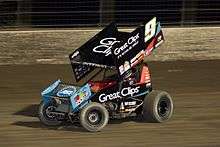
Sprint cars have very high power-to-weight ratios, with weights of approximately 1,400 pounds (640 kg) (including the driver)[1] and power outputs of over 900 horsepower (670 kW) [2] which gives them a power-to-weight ratio besting that of contemporary F1 cars.[3][4] Typically, they are powered by a naturally aspirated, methanol injected over-head valve V8 with an engine displacement of 410 cubic inches (6.7L) capable of engine speeds approaching 9000 rpm.[1][5] Depending on the mechanical setup (engine, gearing, shocks, etc.) and the track layout, these cars can achieve speeds in excess of 160 miles per hour (260 km/h).[1] A lower budget and very popular class of sprint cars uses 360 cubic inch (5.9L) engines that produce approximately 700 horsepower (520 kW). Sprint cars do not utilize a transmission, they have an in or out gear box and quick change rear differentials for occasional gearing changes. As a result, they do not have electric starters (or even electrical systems other than a magneto / ignition) and require a push to start them. The safety record of sprint car racing in recent years has been greatly improved by the use of roll cages, and especially on dirt tracks, wings, to protect the drivers.
Many IndyCar Series and NASCAR drivers used sprint car racing as an intermediate stepping stone on their way to more high-profile divisions, including Indianapolis 500 winners A. J. Foyt, Mario Andretti, Johnny Rutherford, Parnelli Jones, Johnnie Parsons, Al Unser, Sr., and Al Unser, Jr., as well as NASCAR Sprint Cup champions Jeff Gordon and Tony Stewart.
The National Sprint Car Hall of Fame & Museum located in Knoxville, Iowa, USA features exhibits highlighting the history of both winged and wingless sprint cars.
Non-winged sprint cars
There are several sanctioning bodies for non-winged sprint cars. Once dominant United States Automobile Club (USAC) became USAC/California Racing Association (USAC/CRA) after taking over the Sprint Car Racing Association (SCRA). USAC/CRA remains popular on the West Coast/East Coast and in Indiana. USAC also has hosted the Silver Crown series, based in Indiana, for decades. The Silver Crown series was started in 1971 as an offshoot of the series that competed for the National Championship Trail including the Indianapolis 500, known as "big cars".[6] However, lack of leadership in much of the USA has resulted in a large number of groups/sanctioning bodies supporting Non-Winged Sprint Cars.
Non-winged sprint cars are considered the traditional sprint car, dating back to the first sprint cars in the 1930s and 1940s (that ultimately evolved into Indy Cars). Today, they are essentially the same car as a winged sprint car, only without wings. In fact, many of them have the "stub outs" in the frame for adding wings. They generally use the same 410ci and 360ci aluminum engines as their winged counterparts (although many local tracks have rules mandating steel blocks and some 305ci (5.0L) displacements, this is mostly a cost control). Some newer regional groups, specifically POWRi and Elite has chosen to allow Open Engines with no limit to engine size. Their tuning and gearing are different for performance at lower RPMs than a winged car. Chassis set ups and tires are also different.
While they do not have the same top speed as a winged car (because they lack downforce for traction), they are thought by many to be more entertaining to watch. Their relative lack of grip creates different driving characteristics than their winged counterparts, causing them to be more difficult to control through the corners. This, and the lack of roll-over protection a wing provides, makes them more dangerous than winged cars and their crashes are known for their spectacular nature. It is fairly uncommon for a driver to be skilled at driving both winged and non-winged cars (especially at a professional level).
Winged sprint cars
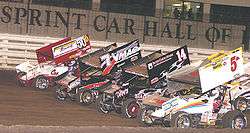
The world's first winged car, known today as a winged sprint car, was created and driven by Jim Cushman at the Columbus Motor Speedway (Ohio) in 1958.[7] In the early 1970s, many sprint car drivers began to put wings with sideboards on both the front and top of their cars. The added wings increased the downforce generated on the car, with the opposite direction of the sideboards helping to turn the car in the corners. The increased traction makes the car faster and easier to control.
The wing also affects safety. The added downforce lessens the likelihood of going airborne. When cars do go airborne, the wings will contact the ground first and break off or crumple upon hitting the ground, lessening the impact on the driver and the car. For these reasons, winged cars are safer to drive and the wings are sometimes referred to as "aluminum courage." Often teams are able to replace the wing during the ensuing stoppage and are able to continue once the race resumes.
In 1978, Ted Johnson formed the promotional body for winged sprint cars called the World of Outlaws. Racing throughout the United States from February to November, the World of Outlaws is the premier dirt sprint car racing series. Famous tracks featured in the series included the Eldora Speedway in Rossburg, Ohio, the Lernerville Speedway in Sarver, Pennsylvania, the Knoxville Raceway in Knoxville, Iowa and Williams Grove Speedway in Mechanicsburg, Pennsylvania. Each August, the Knoxville Raceway holds the Knoxville Nationals.
In 1987, Australia followed suit with its own national series for winged sprint cars called the World Series Sprintcars, founded by Adelaide based sedan driver and then Speedway Park track promoter John Hughes. Famous Australian tracks used in the WSS have included Speedway Park/City in Adelaide, South Australia, Claremont Speedway and later Perth Motorplex in Perth, Western Australia, Valvoline Raceway in Sydney, New South Wales, Archerfield Speedway in Brisbane, Queensland, and the Premier Speedway (home of the Grand Annual Sprintcar Classic) in Warrnambool, Victoria. There is also a single meeting Australian Sprintcar Championship which has been run since 1963 and has been run under various class names before finally settling on the Australian Sprintcar Championship in 1979. While non-Australian (usually American) drivers are free to race in the WSS and other meetings including the various State Championships, only Australian drivers are permitted in the Australian Championship meeting.
The Grand Annual Sprintcar Classic at Warrnambool is the largest sprint car meeting in the world; in the 2014–15 season, the 2015 Classic race outdrew the Knoxville Nationals in entries.
Until the early 2000s, Sprintcars in Australia were restricted to 6200 cc (372 cui) V8 engines as opposed to the 410 cui (6.7 L) engines used in the United States and New Zealand. Brian Healey, the Sacramento (US)-based Australian who owned Parramatta City Raceway, pushed for the change in 2003 to follow both nations to 410. Today, Australia follows the standard 410 ci formula, and has both the 410 and 360 cui (5.9 L) formulae. Both formulae have separate Australian Championship meetings.
Midget cars
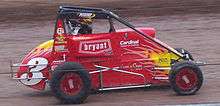
Midget cars are smaller versions of a full size sprint car, normally non-wing only. Midgets date back to the 1930s as a very common form of sprint car racing, still very popular today and also sanctioned by USAC. They are powered by 4-cylinder engines developing around 350 horsepower (260 kW), but are otherwise very similar to their larger cousins.
Mini sprint
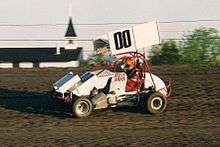
Mini sprints are similarly sized to midget cars, but have an upright-style chassis and a center-mounted, chain-driven 4-cylinder motorcycle engine with a displacement between 750 and 1200 cc.
Micro sprints
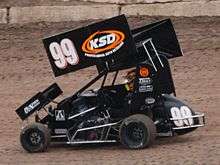
Micro sprints are small racecars that are smaller versions of full sprint cars. A starter class for striving sprint car enthusiasts, they run side-mounted 600 cc motorcycle engines developing around 100 hp and are chain driven. They have a chassis and a body styled like that of a full sized sprint car or midget. Micro sprints are generally run on small dirt tracks that are usually a fifth of a mile or less in size, though they sometimes run on larger tracks. They can be either raced with wings or without wings; the latter are sometimes called micro midgets or 600 cc Sprints. The general minimum weights for the cars to pass tech is 750 lbs for winged and 725 lbs for non wing. Micro sprints are generally a cheaper alternative than racing a mini sprint or a midget sprint, but they can be as expensive as a full-sized sprint car.
Outlaw karts
Outlaw karts are go karts with a roll cage and wing. They are some of the cheapest race cars that are very competitive, costing around $5,000. Most tracks are one sixth of a mile or less. Outlaw karts run side-mounted engines of various types. The beginner boxstock and boxstock divisions run pull start clone motors and are usually for the younger drivers first getting their start. The intermediate division runs a 250 cc dirt bike engine with the driver/team having choice of running a four-stroke or a two-stroke. At some tracks, the intermediate division has to run a harder compound of tire. The biggest and baddest division in outlaw karts is the open division. The opens can run 450 cc four strokes, 500 cc two strokes, or 550 cc four-strokes. The 450 cc and 500 cc motors are the more popular option because the 550 cc motors aren't run at all tracks, and the tracks that do run them make the kart weigh extra. The weight range for the karts is around 150 lb to around 500 lb.
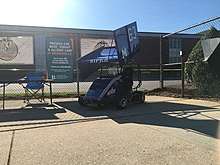
Sanctioning bodies
The NOS Energy Drink World of Outlaws (WoO) is a division of 410ci (6.7L) winged sprint cars that run all over the United States and have a few events in Canada. The cars have 15-inch (380 mm) wide right rear tire and a 410 cubic inch engine with mechanical fuel injection. These sprint cars have no battery or a starter in them, necessitating a push start by a quad or truck. They also do not have flywheels, clutches or transmissions, but the direct drive system can be engaged or disengaged from the cockpit. This is done both for weight reasons and tradition. Another tradition the WoO has pertaining their "A-main" (the last race of the event) is to have the cars line up four wide just before starting the race.
The All Star Circuit of Champions (ASCoC) is an American motorsports sanctioning body of winged sprint car racing founded in 1970. The series sanctions 410ci sprint car races in Ohio, Indiana, Pennsylvania, Michigan, Illinois, Wisconsin, New York, and Florida. On average the series runs 40 races per year, starting February and ending in October each year.
The United States Automobile Club (USAC) National Sprint Car Championship is a division of non-winged 410 cubic inch sprint cars that run throughout the United States on asphalt and dirt tracks. The USAC also sanctions regional 360ci non-winged sprint car series: the USAC East Coast Sprint Cars, USAC Southwest Sprint Cars, and USAC West Coast Sprint Cars.
The United Racing Company (URC) is a division for winged sprint cars that run mainly in the northeastern part of the United States in Pennsylvania, New Jersey, and Delaware. The URC started in 1948 with 11 races in its season. It slowly progressed to 28 races. The URC uses a 360 cubic inch (5.9 L) engine which generates approximately 650 horsepower (480 kW). They race with alcohol fuel and use mechanical fuel injection (MFI) to deliver it into the combustion chamber.
The American Sprint Car Series (ASCS) sanctions both winged and non-winged sprint car racing within the United States. ASCS winged cars use a 360 cubic inch engine which lead to fans calling the cars "360s". The series was started by well-known racing promoter Emmett Hahn. The series national headquarters are in Tulsa, Oklahoma. The all-time leader in wins for the series is Texan Gary Wright with 127 A main victories under his belt.[8] Engine rules for the non-wing cars vary by series with some having unlimited displacement engines.
In Australia, Sprint Car racing is controlled by the Sprintcar Control Council of Australia (SCCA) who sanction the Australian Championships and the World Series Sprintcar series as well as the various State Championships and other meetings held around the country.
Non-winged sprint car series
| Series | Engine | Founded | Countries | Locations |
|---|---|---|---|---|
| AMSOIL USAC National Sprint Car Championship | 410ci | 1956 | Indiana, Arizona, California, Florida, Illinois, Iowa, Nebraska, New Jersey, New York, Ohio, Pennsylvania | |
| USAC/CRA AMSOIL Sprint Car Series | 410ci | 2004 | California, Arizona | |
| POWRi Lucas Oil WAR Sprint League | 410ci | 2012 | Missouri, Kansas, Illinois, Iowa, Oklahoma, Arkansas, Nebraska, Indiana, Wisconsin | |
| Buckeye Outlaw Sprint Series | 410ci | 2011 | Ohio, Indiana, Pennsylvania | |
| Michigan Traditional Sprints | 410ci | 2006 | Michigan, Pennsylvania | |
| Midwest Sprint Car Series | 410ci | 2001 | Illinois, Indiana | |
| USAC East Coast Sprint Cars | 360ci | 2018 | Delaware, New Jersey, New York, Pennsylvania | |
| USAC Southwest Sprint Cars | 360ci | 1991 | Arizona, Nevada, New Mexico | |
| USAC West Coast Sprint Cars | 360ci | 2009 | Arizona, California, Nevada | |
| New Mexico Motor Racing Association | 360ci | 1946 | New Mexico, Texas | |
| Heartland Racing Association | 360ci | 2006 | Minnesota, South Dakota, Iowa | |
| Heart of the West Racing Series | 360ci | 2013 | Minnesota, South Dakota, Wyoming | |
| UMSS Traditional Sprint Car Series | 360ci | 2011 | Minnesota, Wisconsin | |
| Northern Renegades | 360ci | 2017 | Minnesota | |
| C&H presents Hunt Magnetos Sprint Car Series | 360ci (Spec) | California | ||
| V8 Non-wing Sprints Australia | 346ci | 2016 | Queensland, Victoria, West Australia | |
| ASCS Desert Non-Wing Sprints | ???ci | 2019 | Arizona | |
| ASCS Elite Non-Wing Sprints | 305ci
Unlimited (2018+) |
2014 | Texas, Oklahoma, Arkansas | |
| ASCS Elite North Non-Wing Sprints | Unlimited | 2020 | Colorado, Texas | |
| Northeast Wingless Sprint Cars | Crate | 2015 | New Jersey, New York | |
| RUSH Sprint Car Series | Crate | 2018 | Ohio, Pennsylvania | |
| Wisconsin Wingless Sprint Series | Crate | 2015 | Wisconsin | |
| Australian Wingless Sprint Racing | V6 | New South Wales, Northern Territory, Queensland, South Australia, Tasmania, Victoria, West Australia |
Winged sprint car series
| Series | Engine | Founded | Countries | Locations |
|---|---|---|---|---|
| World of Outlaws Sprint Car Series | 410ci | 1978 | 27 states including Canada | |
| All Star Circuit of Champions | 410ci | 1970 | Florida, Michigan, Minnesota, New York, North Dakota, Ohio, Pennsylvania, South Dakota, Wisconsin, Oklahoma, Texas, Louisiana, Tennessee, Illinois, Indiana | |
| Great Lakes Super Sprints | 360ci | 2015 | Indiana, Michigan, Ohio, Canada | |
| National Sprint League (ended) | 410ci | 2014-2016 | Iowa, Missouri, Illinois, Minnesota, Nebraska, Wisconsin, South Dakota | |
| IRA Outlaw Sprint Series | 410ci | 1967 | Illinois, Wisconsin | |
| King of the West 410 Sprint Car Series | 410ci | 1960 | California | |
| Sprintcar Challenge Tour | 360ci | 2017 | California | |
| Midwest Open Wheel Association Sprint Car Series | 410ci | Illinois, Iowa, Missouri | ||
| Northern Outlaws Sprint Association | 410ci | 1994 | Manitoba, Minnesota, North Dakota | |
| Ohio Valley Sprint Car Association | 410ci | 2010 | Ohio, West Virginia | |
| Fremont/Attica Sprint Title | 410ci &305ci | 2009 | Ohio, Michigan, Pennsylvania | |
| Ohio Sprint Car Series | 410ci | 2016 | Ohio | |
| Lucas Oil American Sprint Car Series | 360ci | 1992 | Arizona, Arkansas, Iowa, Kansas, Minnesota, Missouri, Montana, Nebraska, New Mexico, Oklahoma, South Dakota, Tennessee, Texas | |
| Civil War Sprint Car Series | 360ci | 1993 | California | |
| Empire Super Sprints | 360ci | 1983 | New Jersey, New York, Ontario, Pennsylvania, Quebec | |
| Midwest Sprintcar Association | 360ci | 1996 | Wisconsin | |
| Nebraska 360 Sprint Series | 360ci | Iowa, Kansas, Nebraska, South Dakota | ||
| Patriot Sprint Tour | 360ci | 2003 | New York, Ohio, Pennsylvania, Ontario | |
| Southern Ontario Sprints | 360ci | 1996 | Ontario | |
| Sprint Cars of New England | 360ci | 2004 | New Hampshire, Vermont | |
| Sprints on Dirt | 360ci | Indiana, Michigan, Ohio, Ontario | ||
| United Racing Club | 360ci | 1948 | Delaware, New Jersey, New York, Pennsylvania | |
| United Sprint Car Series | 360ci | Alabama, Arkansas, Georgia, Mississippi, Missouri, North Carolina, South Carolina, Tennessee | ||
| Upper Midwest Sprint Car Series | 360ci | 2009 | Iowa, Minnesota, Wisconsin | |
| World Series Sprintcars | 410ci | 1987 | New South Wales, Queensland, South Australia, Western Australia, Victoria | |
| Oval Superstars Tour | 410ci | 2016 | North Island including Wellington, Palmerston North, Napier, Stratford, Huntly | |
| Ultimate Sprintcar Championship | 410ci | 2014 | New South Wales, Queensland, South Australia, Victoria | |
| Sprintcar All Stars | 360ci | 2007 | New South Wales, South Australia, Victoria |
Sprint Car World Championship
Despite 50 plus years of Sprint car racing, the category has only ever held one unofficial "world championship". This was in 1987 at the ⅓ mile (586 metres (641 yd)) Claremont Speedway in Perth, Western Australia. The event attracted a collection of drivers from Australia, NZ, Canada, and South Africa, as well as several World of Outlaws drivers. Australian veteran Garry Rush from Sydney, a 10-time winner of the Australian Sprintcar Championship, was the winner.
Television coverage
United States
Non-winged cars were televised first when USAC had an ESPN television contract. The first national live television deal with winged sprint cars came on The Nashville Network (TNN) in 1992–93 and again in 1993–94 with a winter-based series in Arizona, which featured Mike Joy calling the action. Live coverage of the Knoxville Nationals on The Nashville Network began in 1995. A year later, a next-day tape deal with CBS for one race at Eldora Speedway aired while TNN coverage expanded. By 2000, CBS (which owned TNN at the time) announced TNN would air 15 live events, including the King's Royal at Eldora Speedway and the Knoxville Nationals. By the 2001 season, plans were to cover 18 live races, but midway through the season MTV Networks closed the CBS motorsports operations. This move relegated the remainder of the World of Outlaws season to tape delay races. A tape delayed deal with the Speed Channel followed for the next season. Television coverage began on The Outdoor Channel in 2003. Events are usually tape delayed for two weeks or more. The Knoxville Nationals were on Speed Channel. The 2005 Knoxville Nationals did not air as bad weather postponed the event, and there was not enough space for Speed to air the event, won by Kraig Kinser. In 2003, Johnson sold his organization to DIRT Motorsports. Because of complaints about DIRT Motorsports and the lack of television coverage, Northwest Sprint Tour owner Fred Brownfield formed the National Sprint Tour as a rival to the World of Outlaws Sprint for the 2006 season. Notable teams in the NST included Steve Kinser Racing (#11), Roth Motorsports (sometimes known as the "Beef Packers" team) (#83), Tony Stewart Racing (#20). After Brownfield Promotions' owner Fred Brownfield was killed in a crash, Kinser and principals of two other teams purchased the entire Brownfield promotion. That series folded after the 2006 season, while the Northwest tour, a regional tour, was sold. The SuperClean Summer of Money aired on ESPN2 starting in mid June 2008 with the World of Outlaws at Knoxville Raceway and for 8 weeks straight leading up to the Knoxville Nationals which were live on SPEED. In 2015, the World of Outlaws have had several races broadcast on CBS Sports Network. Knoxville Raceway has their weekly series as well as World of Outlaws & National Sprint League events on MavTV. USAC currently has some races televised on MavTV, primarily through Jack Slash Media's Dirty 30 highlights program. Other series such as the Lucas Oil ASCS Sprint Car Series, King of the West Sprint Cars, King of the Wing Pavement Sprint Cars, and several weekly/regional series also air on MavTV.
Australia
In Australia, the World Series Sprintcars was formerly televised on free-to-air channel One HD.
Safety aspects
Sprint car racing in recent years has several new mandatory safety regulations including the use of roll cages to protect the drivers, fuel tank bladders to prevent fuel leakage, alcohol fuel, requirements to use a six or seven-point safety harness seatbelt two years old or newer, and driver suit standards to consist of two layers and rated at least SFI 3.2A/5. In addition, drivers must wear nomex driving gloves. Other equipment requirements include: helmets must be full coverage and must exceed Snell 2000 rating; arm restraints systems must be used; cars must have a 1/8 inch wire debris/rock screen in the front roll cage opening covering the entire opening; and headrests mandatory on the right side of the drivers seat. Some sanctioning bodies are also requiring a head and neck restraint system.
Winged sprint cars also have the wing as an additional safety aspect. Winged sprint cars are able to marginally improve their safety with wings that absorb some of the energy from violent flips and crashes, although winged sprint cars generally travel at higher speeds than their non-wing counterparts.
See also
- List of National Sprint Car Hall of Fame inductees
- National Sprint Car Hall of Fame & Museum
- World of Outlaws
- Knoxville Nationals
- National Sprint Tour
- Australian Sprintcar Championship
- Grand Annual Sprintcar Classic
- World Series Sprintcars
- Oval Superstars Tour
- Australian Sprintcar Grand Prix
- Open sportsman
References
- http://www.williamsgrove.com/divisions.htm
- https://www.ewarbirds.org/automotive/sprintcars.shtml
- "Google". www.google.com.
- "Tony Stewart's Sprint Car Racing Arrives This Month on Console and PC". GTPlanet. February 11, 2020.
- "Sprint Car Specs". Corey Houseman. Retrieved 2009-11-11.
- "SAC Silver Crown specs and history". Archived from the original on September 29, 2007.
- Brown, Allan (2003). The History of America's Speedways - Past & Present. Third Edition. ISBN 0-931105-61-7.
- "ASCS - Lucas Oil National Sprint Cars | American Sprint Car Series". www.ascsracing.com.
External links
| Wikimedia Commons has media related to Sprint car racing. |